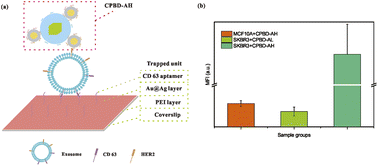Metal nanoprobe-decorated all-inorganic perovskite nanocrystal-based fluorescence-linked immunosorbent assay for the detection of tumor-derived exosomes†
Abstract
All-inorganic perovskite nanocrystals (CsPbX3 NCs, X = Cl, Br, I) are promising fluorescence materials for biological detection due to their excellent optical properties. However, there is still a challenge to obtain stable CsPbX3 NCs with more biofunctions. Here, we proposed a distinct strategy by absorbing the functionalized metal nanoprobes onto the phospholipid encapsulated CsPbX3 NCs to achieve CsPbX3-metal hybrids as probes for the detection of tumor-derived exosomes. Here, the metal nanoprobes have two functions: first, it endows phospholipid encapsulated CsPbX3 NCs with recognition ability; second, it avoids the fluorescence quenching of CsPbX3 NCs during the biological modification process by using metal nanoparticles as a bridge to connect with CsPbX3 NCs and various biomolecules. The obtained CPXD–AD exhibited a bright fluorescence signal, narrow full width at half-maximum (FWHM), and high specificity. Under optimal conditions, the CPXD–AD-based fluorescence-linked immunosorbent assay (FLISA) was successfully established and used for both qualitative and quantitative detection of tumor-derived exosomes.

- This article is part of the themed collection: Analytical Methods HOT Articles 2023


 Please wait while we load your content...
Please wait while we load your content...